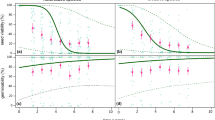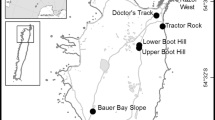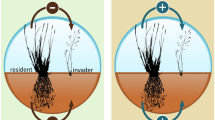Abstract
Many invasive plants originate as cultivated species. The growing demand for renewable energy has stimulated agricultural production of native and non-native perennial grasses, but little is known about their potential to become invasive outside cultivation, particularly at the early establishment phase. We evaluated effects of propagule pressure and establishment limitations for early establishment of four potential bioenergy grasses in agricultural field margins and forest understory across a 6.3° latitudinal gradient (Ontario, Canada; Illinois and Virginia, USA). We used multiple seed introductions in different years and followed their fate for up to three growing seasons. High interannual variability in establishment indicates that the frequency of propagule introduction is important for invasion outside cultivation. Establishment limitations were stronger in forest than field margins; of 328,800 seeds added, only 1 of 505 persisting seedlings occurred in forest. Removal of competing vegetation had small and variable effects on establishment among sites and species. Unlike previous short-term experiments, our results indicate the potential for the persistence of these bioenergy grasses in both vegetation and seed bank, and highlight the importance of long-term experiments in evaluating invasion risk.




Similar content being viewed by others
References
Barney JN, DiTomaso JM (2008) Nonnative species and bioenergy: are we cultivating the next invader? Bioscience 58:64–70. doi:10.1641/B580111
Barney JN, Mann JJ, Kyser GB, DiTomaso JM (2012) Assessing habitat susceptibility and resistance to invasion by the bioenergy crops switchgrass and Miscanthus x giganteus in California. Biomass Bioenerg 40:143–154. doi:10.1016/j.biombioe.2012.02.013
Catford JA, Jansson R, Nilsson C (2009) Reducing redundancy in invasion ecology by integrating hypotheses into a single theoretical framework. Divers Distrib 15:22–40. doi:10.1111/j.1472-4642.2008.00521.x
Christian D, Yates N, Riche A (2005) Establishing Miscanthus sinensis from seed using conventional sowing methods. Ind Crop Prod 21:109–111. doi:10.1016/j.indcrop.2004.01.004
Clark CJ, Poulsen JR, Levey DJ, Osenberg CW (2007) Are plant populations seed limited? A critique and meta-analysis of seed addition experiments. Am Nat 170:128–142. doi:10.1086/518565
Colautti RI, Grigorovich IA, MacIsaac HJ (2006) Propagule pressure: a null model for biological invasions. Biol Invasions 8:1023–1037. doi:10.1007/s10530-005-3735-y
Connell JH, Slatyer RO (1977) Mechanisms of succession in natural communities and their role in community stability and organization. Am Nat 111:1119–1144. doi:10.1086/283241
Davis MA, Grime JP, Thompson K (2000) Fluctuating resources in plant communities: a general theory of invasibility. J Ecol 88:528–534. doi:10.1046/j.1365-2745.2000.00473.x
DiTomaso JM, Barney JN, Mann JJ, Kyser G (2013) For switchgrass cultivated as biofuel in California, invasiveness limited by several steps. Calif Agric 67:96–103. doi:10.3733/ca.v067n02p96
Drake JM, Lodge DM (2006) Allee effects, propagule pressure and the probability of establishment: risk analysis for biological invasions. Biol Invasions 8:365–375. doi:10.1007/s10530-004-8122-6
Drake JM, Baggenstos P, Lodge DM (2005) Propagule pressure and persistence in experimental populations. Biol Lett 1:480–483. doi:10.1098/rsbl.2005.0375
Flory SL, Lorentz KA, Gordon DR, Sollenberger LE (2012) Experimental approaches for evaluating the invasion risk of biofuel crops. Environ Res Lett 7:045904. doi:10.1088/1748-9326/7/4/045904
Germain RM, Johnson L, Schneider S, Cottenie K, Gillis EA, MacDougall AS (2013) Spatial variability in plant predation determines the strength of stochastic community assembly. Am Nat 182:169–179. doi:10.1086/670928
Gutterson NI, Klingenberg JP, Pereira MA, Engler DE, Jakob K (2014) Odd-ploidy, seed-propagated Miscanthus × giganteus. U.S. Patent 20140033342 A1, Jan 30, 2014
Hager HA, Stewart FEC (2013) Suspected selective herbivory of bioenergy grasses by meadow voles (Microtus pennsylvanicus). Can Field Nat 127:44–49
Hager HA, Quinn LD, Barney JN, Voigt TB, Newman JA (2015a) Germination and establishment of bioenergy grasses outside cultivation: a multi-region seed addition experiment. 2012 to 2014 [Ontario, Canada and Illinois and Virginia, United States of America]. V1. Agri-Environmental Research Data Repository. http://hdl.handle.net/10864/NHXOM
Hager HA, Rupert R, Quinn LD, Newman JA (2015b) Escaped Miscanthus sacchariflorus reduces the richness and diversity of vegetation and soil seed bank. Biol Invasions 17:1833–1847. doi:10.1007/s10530-014-0839-2
Harper JL (1977) Population biology of plants. Academic Press, London
Hedge LH, O’Connor WA, Johnston EL (2012) Manipulating the intrinsic parameters of propagule pressure: implications for bio-invasion. Ecosphere 3:UNSP 48. doi: 10.1890/ES11-000375.1
Higgins SI, Richardson DM (1999) Predicting plant migration rates in a changing world: the role of long-distance dispersal. Am Nat 153:464–475. doi:10.1086/303193
Jakubowski AR, Jackson RD, Casler MD (2014) The history of reed canarygrass in North America: persistence of natives among invading Eurasian populations. Crop Sci 54:210–219. doi:10.2135/cropsci2013.05.0342
Johnstone IM (1986) Plant invasion windows: a time-based classification of invasion potential. Biol Rev 61:369–394
Jongejans E, Skarpaas O, Tipping PW, Shea K (2007) Establishment and spread of founding populations of an invasive thistle: the role of competition and seed limitation. Biol Invasions 9:317–325. doi:10.1007/s10530-006-9035-3
Keane R, Crawley M (2002) Exotic plant invasions and the enemy release hypothesis. Trends Ecol Evol 17:164–170. doi:10.1016/S0169-5347(02)02499-0
Kempel A, Chrobock T, Fischer M, Rohr RP, van Kleunen M (2013) Determinants of plant establishment success in a multispecies introduction experiment with native and alien species. Proc Natl Acad Sci USA 110:12727–12732. doi:10.1073/pnas.1300481110
Kludze H, Deen B, Weersink A, van Acker R, Janovicek K, De Laporte A (2013) Impact of land classification on potential warm season grass biomass production in Ontario, Canada. Can J Plant Sci 93:249–260. doi:10.4141/CJPS2012-143
Leck M (1996) Germination of macrophytes from a Delaware River tidal freshwater wetland. Bull Torrey Bot Club 123:48–67. doi:10.2307/2996306
Lockwood JL, Cassey P, Blackburn T (2005) The role of propagule pressure in explaining species invasions. Trends Ecol Evol 20:223–228. doi:10.1016/j.tree.2005.02.004
Mack R, Erneberg M (2002) The United States naturalized flora: largely the product of deliberate introductions. Ann Mo Bot Gard 89:176–189. doi:10.2307/3298562
Mack RN, Simberloff D, Lonsdale WM, Evans H, Clout M, Bazzaz FA (2000) Biotic invasions: causes, epidemiology, global consequences, and control. Ecol Appl 10:689–710. doi:10.2307/2641039
Martin LM, Wilsey BJ (2012) Assembly history alters alpha and beta diversity, exotic-native proportions and functioning of restored prairie plant communities. J Appl Ecol 49:1436–1445. doi:10.1111/j.1365-2664.2012.02202.x
Matlaga DP, Schutte BJ, Davis AS (2012) Age-dependent demographic rates of the bioenergy crop Miscanthus × giganteus in Illinois. Invasive Plant Sci Manag 5:238–248. doi:10.1614/IPSM-D-11-00083.1
Miller AL, Diez JM, Sullivan JJ, Wangen SR, Wiser SK, Meffin R, Duncan RP (2014) Quantifying invasion resistance: the use of recruitment functions to control for propagule pressure. Ecology 95:920–929. doi:10.1890/13-0655.1
Minton MS, Mack RN (2010) Naturalization of plant populations: the role of cultivation and population size and density. Oecologia 164:399–409. doi:10.1007/s00442-010-1667-4
Parker IM (2001) Safe site and seed limitation in Cytisus scoparius (Scotch broom): invasibility, disturbance, and the role of cryptogams in a glacial outwash prairie. Biol Invasions 3:323–332. doi:10.1023/A:1015855515361
Pearson DE, Callaway RM, Maron JL (2011) Biotic resistance via granivory: establishment by invasive, naturalized, and native asters reflects generalist preference. Ecology 92:1748–1757
Pyšek P, Manceur AM, Alba C, McGregor KF, Pergl J, Štajerová K, Chytrý M, Danihelka J, Kartesz J, Klimešová J, Lučanová M, Moravcová L, Nishino M, Sádlo J, Suda J, Tichý L, Kühn I (2015) Naturalization of central European plants in North America: species traits, habitats, propagule pressure, residence time. Ecology 96:762–774. doi:10.1890/14-1005.1
Quinn LD, Matlaga DP, Stewart JR, Davis AS (2011) Empirical evidence of long-distance dispersal in Miscanthus sinensis and Miscanthus × giganteus. Invasive Plant Sci Manag 4:142–150. doi:10.1614/IPSM-D-10-00067.1
Quinn L, Stewart J, Yamada T, Toma Y, Saito M, Shimoda K, Fernández F (2012) Environmental tolerances of Miscanthus sinensis in invasive and native populations. BioEnerg Res 5:139–148. doi:10.1007/s12155-011-9163-1
Richardson DM, Pyšek P, Rejmánek M, Barbour MG, Panetta FD, West CJ (2000) Naturalization and invasion of alien plants: concepts and definitions. Divers Distrib 6:93–107. doi:10.1046/j.1472-4642.2000.00083.x
Ross MA, Harper JL (1972) Occupation of biological space during seedling establishment. J Ecol 60:77–88. doi:10.2307/2258041
Samson R (2007) Switchgrass production in Ontario: a management guide. Resource Efficient Agricultural Production, Ste-Anne-de-Bellevue
Simberloff D (2009) The role of propagule pressure in biological invasions. Ann Rev Ecol Evol Syst 40:81–102. doi:10.1146/annurev.ecolsys.110308.120304
Smith LL, Barney JN (2014) The relative risk of invasion: evaluation of Miscanthus × giganteus seed establishment. Invasive Plant Sci Manag 7:93–106. doi:10.1614/IPSM-D-13-00051.1
Smith WK, Cleveland CC, Reed SC, Miller NL, Runnin SW (2012) Bioenergy potential of the United States constrained by satellite observations of existing productivity. Environ Sci Technol 46:3536–3544. doi:10.1021/es203935d
Stroup WW (2013) Generalized linear mixed models: modern concepts, methods and applications. CRC Press, Boca Raton
Thomsen MA, D’Antonio CM, Suttle KB, Sousa WP (2006) Ecological resistance, seed density and their interactions determine patterns of invasion in a California coastal grassland. Ecol Lett 9:160–170. doi:10.1111/j.1461-0248.2005.00857.x
Turnbull LA, Crawley MJ, Rees M (2000) Are plant populations seed-limited? A review of seed sowing experiments. Oikos 88:225–238. doi:10.1034/j.1600-0706.2000.880201.x
West NM, Matlaga DP, Davis AS (2014) Quantifying targets to manage invasion risk: light gradients dominate the early regeneration niche of naturalized and pre-commercial Miscanthus populations. Biol Invasions 16:1991–2001. doi:10.1007/s10530-014-0643-z
Western University Research Park (2012) Assessment of business case for purpose-grown biomass in Ontario. Western University Research Park, Sarnia
Williamson M, Fitter A (1996) The varying success of invaders. Ecology 77:1661–1666. doi:10.2307/2265769
Yakimowski SB, Hager HA, Eckert CG (2005) Limits and effects of invasion by the nonindigenous wetland plant Lythrum salicaria (purple loosestrife): a seed bank analysis. Biol Invasions 7:687–698. doi:10.1007/s10530-004-5858-y
Zhang J, Maun M (1994) Potential for seed bank formation in 7 Great Lakes sand dune species. Am J Bot 81:387–394. doi:10.2307/2445486
Acknowledgments
This research was funded by the Ontario Ministry of Agriculture, Food and Rural Affairs; the Energy Biosciences Institute; and a Mitacs Elevate fellowship to HAH. Mendel Biotechnology generously provided M. × giganteus Powercane™ seed. We thank K. Bolton, F. Cybula, M. Ho, R. Luttrell, E. Palmer, A. Patchett, K. Shukla, and R. Viejou for assistance in the field; J. Malecki for providing field margin space in Ontario; and L. Smith for providing comparative data.
Author information
Authors and Affiliations
Corresponding author
Additional information
Communicated by Devan Allen McGranahan.
Electronic supplementary material
Below is the link to the electronic supplementary material.
Rights and permissions
About this article
Cite this article
Hager, H.A., Quinn, L.D., Barney, J.N. et al. Germination and establishment of bioenergy grasses outside cultivation: a multi-region seed addition experiment. Plant Ecol 216, 1385–1399 (2015). https://doi.org/10.1007/s11258-015-0516-2
Received:
Accepted:
Published:
Issue Date:
DOI: https://doi.org/10.1007/s11258-015-0516-2




